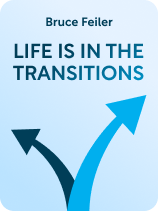

This article is an excerpt from the Shortform book guide to "Life Is in the Transitions" by Bruce Feiler. Shortform has the world's best summaries and analyses of books you should be reading.
Like this article? Sign up for a free trial here.
Why is creativity therapeutic? How can you be more creative?
Navigating life changes can be difficult, but in Life Is in the Transitions, Bruce Feiler argues that you can make it easier by approaching it intentionally and proactively. One of the methods he proposes for adapting to life changes is tapping into your creativity.
Continue reading to learn how you can become more creative.
Tapping Into Creativity
In Feiler’s research, he found that many people turned to creative outlets during transitional periods of their lives. He explains that creating something can be cathartic, and it’s also a good way to explore the new feelings and ideas that result from transformational experiences.
(Shortform note: In Bittersweet, Susan Cain argues that sadness, which Feiler says often accompanies life changes, can trigger creativity in people who aren’t naturally creative. It does so by priming your mind for the high level of focus, openness, and problem-solving that allows you to see how sadness and beauty intersect.)
Here are four ways you can tap into your creativity:
Pick up an art or craft you’ve never tried before. Transitions can leave you feeling isolated, bored, or confused. Feiler says these emotions make excellent creative fodder, since they make space for innovative ideas and out-of-character interests to pop up. This makes transitions an excellent opportunity to stretch your creative limits.
(Shortform note: If you’re not sure which new art or craft to try, understanding your play personality could help you figure it out. Researchers say everyone has a unique style of playfulness, and different styles lend themselves well to different kinds of artistic expression. For example, if your play personality is the joker, you might try an outlet that allows for humor and experimentation, like writing comedy sketches or creating quirky sculptures.)
Resume an art or craft you forgot you loved. Many people exhibit artistic talents as children or young adults, but they put them aside as life becomes busier and priorities shift. According to Feiler, transitions are a good opportunity to reconnect with the artistic side of yourself. (Shortform note: This strategy of Feiler’s could not only help you embrace creativity but also help you stabilize your identity as you deal with uncertainty during a transformation. In Awaken Your Genius, Varol argues that exploring the creative interests you had when you were young is a great way to understand the core of your identity, since those interests are deeply embedded in your psyche.)
Find new ways to move your body. Feiler argues that physical movement can unlock ideas and aspects of your personality that have been lying dormant. For example, starting a yoga practice could teach you to connect with your emotions and could promote a sense of inner calm. (Shortform note: In The Artist’s Way, Julia Cameron explains that experimenting with movement can help you connect with your inner artist. According to Cameron, moving your body allows you to stop hyperfixating on your thoughts and bring your attention to your physical experience and external surroundings. This helps you become more in tune with your feelings and more likely to notice beauty and other sources of inspiration.)
Take up writing. Writing helps you organize your thoughts and make sense of your experiences. Feiler says this is especially helpful when you’re experiencing turbulence after a transformative life change.
(Shortform note: Keeping a journal or writing a memoir are obvious avenues for exploring your thoughts and experiences, but writing fiction may offer similar benefits, too. You can use your own life as inspiration for your fiction, creating characters and storylines that reflect your transformation and allow you to explore your shifting sense of meaning. In Story, screenwriter Robert McKee argues that good stories are those that give us insight into the meaning of life—so this approach could allow you to create a work of fiction others would benefit from reading, too.)

———End of Preview———
Like what you just read? Read the rest of the world's best book summary and analysis of Bruce Feiler's "Life Is in the Transitions" at Shortform.
Here's what you'll find in our full Life Is in the Transitions summary:
- How to deal with curveballs and obstacles in life
- The pattern that most of life’s disruptions follow
- How to rewrite your life story in a positive way






